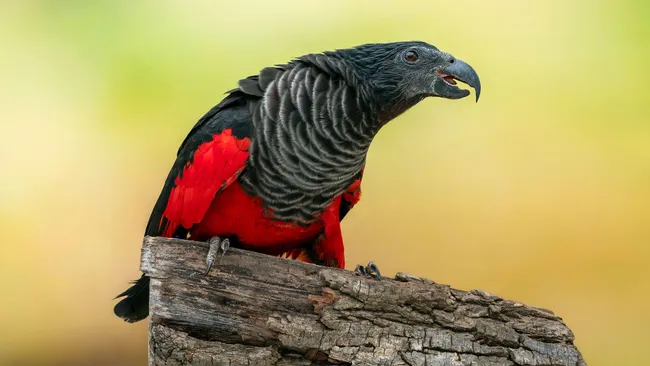Pesquet’s parrot, also known as a Dracula parrot, resembles a vulture and has a distinct scream — but its favorite food is figs.
Name: Dracula Parrot (Psittrichas fulgidus)
Habitat: Rainforests of New Guinea
Diet: Primarily figs, along with flowers and nectar
What Makes It Fascinating:
Nicknamed the Dracula parrot, the Pesquet’s parrot is known for its striking appearance—jet-black feathers contrasted with vivid blood-red patches make it look like it flew straight out of a gothic tale. Add in its eerie, guttural cries that echo through the forest, and you’ve got one of the most metal birds on the planet.
These parrots reach about 18 inches (46 cm) in length and weigh between 1.3 and 1.8 pounds (600–800 grams). With a lifespan ranging from 20 to 40 years, they sport mostly black and dark grey plumage, accented with scarlet feathers on the belly, wings, and tail. Males can be identified by the red markings behind their eyes.
Unlike the cheerful chirps of many parrots, the Dracula parrot emits rasping, screech-like calls that sound more like a monster than a bird. These intense sounds likely help them communicate through the dense rainforest canopy and may serve as warnings or to claim territory. The birds often scream while flying—probably to stay in touch with their group in areas where visibility is low due to thick foliage.
Their vulture-like appearance—marked by a hooked beak and partially bald head—isn’t just for looks. The bare skin helps them avoid getting sticky pulp and juice matted into their feathers as they feed on soft fruits, particularly figs. Despite their fearsome nickname, they’re completely non-carnivorous.
Breeding behavior isn’t well documented, but it’s believed that these birds nest in the hollows of large trees, typically laying just one or two eggs per year.
Sadly, their vivid feathers and exotic appearance have made them targets for illegal trade, both for collectors and the pet market. As a result, Dracula parrots are listed as Vulnerable on the IUCN Red List, and their populations are in decline.
